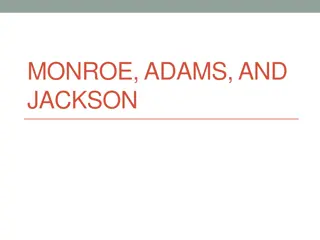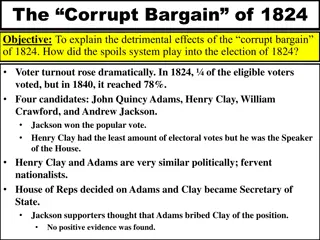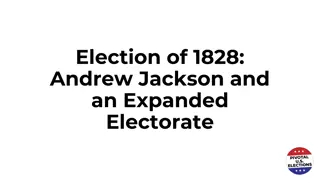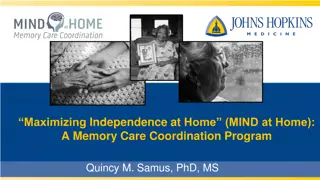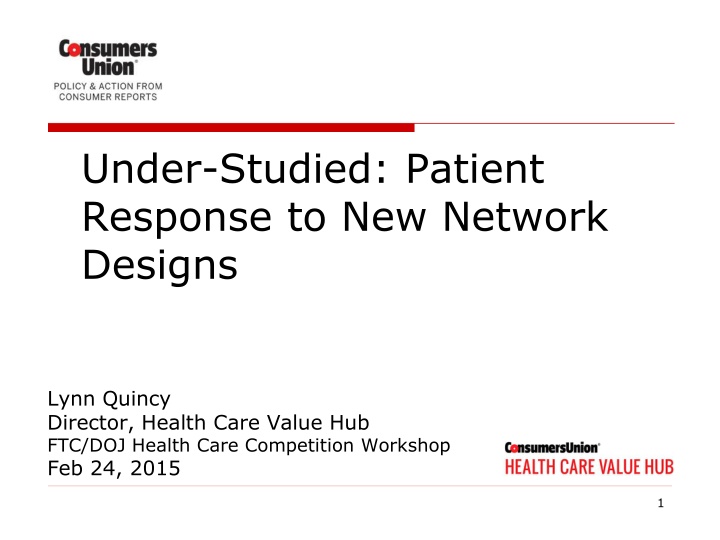
Patient Response to New Network Designs: Understudied Insights
This article discusses the underexplored topic of patient response to new network designs in healthcare. It highlights the importance of network design as a cost control tool and consumer perspectives on health insurance costs. The limited awareness and understanding among consumers regarding tiered physician networks raise concerns about the effectiveness of these designs in improving healthcare decision-making.
Download Presentation

Please find below an Image/Link to download the presentation.
The content on the website is provided AS IS for your information and personal use only. It may not be sold, licensed, or shared on other websites without obtaining consent from the author. If you encounter any issues during the download, it is possible that the publisher has removed the file from their server.
You are allowed to download the files provided on this website for personal or commercial use, subject to the condition that they are used lawfully. All files are the property of their respective owners.
The content on the website is provided AS IS for your information and personal use only. It may not be sold, licensed, or shared on other websites without obtaining consent from the author.
E N D
Presentation Transcript
Under-Studied: Patient Response to New Network Designs Lynn Quincy Director, Health Care Value Hub FTC/DOJ Health Care Competition Workshop Feb 24, 2015 1
Network design is an important cost control tool Consumers care deeply about health insurance costs Providers direct most of our nation s health care spending Narrow- and tiered-network designs have the potential to identify efficient, high-value providers. 2
We dont know patient response to these new designs Only one study1 directly observes patient response: Consumer experience in health plans with tiered physician networks in Massachusetts found relatively low awareness and use of the network design among plan enrollees and low rates of trust in their health plan as a source of information for identifying better physicians. Despite GIC efforts to inform its members about these tiered physician networks, in 2008 only half (49.5 percent) of enrollees had knowledge of the tiered networks in their health plan, and only 19 percent knew one of their doctors' tier ranking. As a result, we should be circumspect about attributing consumer understanding and endorsement just because they enroll in plans featuring newer networking designs. 3 1Sinaiko AD, Rosenthal MB. American Journal of Managed Care, 2010
Theoretically, consumers embrace the idea in order to keep costs down In controlled experiments, given accurate information, a variety of options, and a valid structure for weighing the pros and cons, consumers report they prefer to narrow their provider choices in order to preserve or increase medical benefits. 4 Source: http://healthaffairs.org/blog/2014/11/13/reforming-medicare-what-does- the-public-want/ and other work by Marge Ginsburg
In reality, consumers will likely to struggle to navigate these designs Consumers lack a basic understanding of the role of provider networks, leaving them ill-prepared to make informed health care decisions. This poor understanding is likely compounded by narrow- and tiered- network structures. 5
Sobering data... Only one-third of Americans (36%) understand that HMO stands for health maintenance organization. Only one-fifth (20%) recall that PPO stands for Preferred Provider Organization. 6 Source: https://www.ehealthinsurance.com/content/expertcenterNew/Demystifying- Health-Insurance-Survey-Results-01-10-08.pdf
More sobering data When presented with descriptions of possible provider network features, 50% or fewer could correctly describe HMO and PPO network characteristics. Knowledge of plan types % correct What is generally true of health maintenance organizations (HMOs)? What is generally true of preferred provider organizations (PPOs)? In general, what type of health plan tends to give fewer choices of doctors? 49.2 22.7 51.3 Important: This survey also found that consumers are overconfident in their knowledge, so self-reports of health plan knowledge must be weighed appropriately. Source: data extract from AIR s new health insurance literacy measurement tool. See: http://aircpce.org/health-insurance-literacy-measure-hilm-publications 7
Consumer Protections Are Weak Current standards for network adequacy are weak and rely heavily on self-reported data by health plans. There are NO consumer-tested, validated summary measures to tell the shopper: Is the network narrow or broad? Is the network high quality or just low cost? Or neither? What is the level of financial protection if out-of-network providers are used? 8
Provider Directories: Important but Often Inaccurate A variety of studies find inaccuracy rates of 50% and greater. Provider directory information: Is often out of date, erroneous or incomplete; Hard for consumers to find; Hard to match directory info with the plan under consideration; and Is generally not audited by independent third parties. 9
New Rules to Make the Market Work Better Robust requirements to ensure accuracy of provider directories. Remedies for consumers that rely on erroneous provider directory info. Robust minimum standards for network adequacy that use the same audited standard for all plans in a given geographic area. Summary measures of relative network strength so consumers can rank plan choices based on network strength. Plan rubric for assembling network must be transparent. 10


